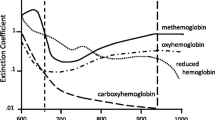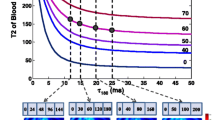Abstract
Objective.Reflectance pulse oximetry permits the use of alternative monitoring sites such as the face or torso, and is the approach commonly employed in fetal pulse oximetry systems. The purpose of this study is to investigate the impact of assumptions about the nature of arterial pulsatility on the calibration of such systems. Methods. Monte Carlo simulations of reflectance pulse oximetry were run on a six-layer tissue model, varying depth and magnitude of the arterial pulse. SpO2 readings on and off the femoral artery obtained during desaturation studies in newborn piglets were compared to predictions. Results. Monte Carlo simulation results clarified the difference between deep and shallow pulsatility found with photon diffusion models, agreeing with earlier in vivo observations. Significant overestimation of SpO2 75% and slight underestimation > 75% is expected if a sensor is placed on a highly pulsatile site. The on- and off-artery SpO2 readings recorded during desaturation in the newborn piglet follow the model predictions. Conclusions. The sensitivity of reflectance pulse oximetry calibration to the depth and magnitude of arterial pulsatility reinforces the observation that monitoring site selection is of importance in optimizing reflectance pulse oximetry performance, particularly fetal pulse oximetry. Sites with palpable pulsatility should be avoided.
Similar content being viewed by others
References
Kelleher JF. Pulse oximetry. J Clin Monit 1989; 5: 37–62.
Kurth CD, Steven JM, Swedlow D. New frontiers in pulse oximetry. Am J Anesthesiol 1996; 23: 169–175.
Mendelson Y, Ochs BD. Noninvasive pulse oximetry utilizing skin reflectance photoplethysmography. IEEE Trans Biomed Eng 1988; 35: 798–805.
Nijboer JA, Dorlas JC, Mahieu HF. Photoelectric plethysmography – some fundamental aspects of the reflection and transmission method. Clin Phys Physiol Meas 1981; 2: 205–215.
Kim JM, Arakawa K, Benson KT, Fox DK. Pulse oximetry and circulatory kinetics associated with pulse volume amplitude measured by photoelectric plethysmography. Anesth Analg 1986; 65: 1333–1339.
Secker C, Spiers P. Accuracy of pulse oximetry in patients with low systemic vascular resistance. Anaesthesia 1997; 52: 127–130.
Reuss JL. Arterial pulsatility and the modeling of reflectance pulse oximetry. Proceedings of 25th Annual International Conference of the IEEE Engineering in Medicine and Biology Society, 2003, pp. 2791–2794.
Shelley KH, Dickstein M, Shulman SM. The detection of peripheral venous pulsation using the pulse oximeter as a plethysmograph. J Clin Monit 1993; 9: 283–287.
Sami HM, Kleinman BS, Lonchyna VA. Central venous pulsations associated with a falsely low oxygen saturation measured by pulse oximetry. J Clin Monit 1991; 7: 309–312.
Nijland R, Jongsma HW, van den Berg PP, Nijhuis JG, Oeseburg B. The effect of pulsating arteries on reflectance pulse oximetry: measurements in adults and neonates. J Clin Monit 1995; 11: 118–122.
Nijland R, Jongsma HW, Verbruggen IM, Nijhuis JG. Reflectance pulse oximetry in fetal lambs: subcutaneous vessels and vasoconstriction affect its reliability. J Clin Monit 1996; 12: 225–230.
Chez BF, Harvey MG, Harvey CJ. Intrapartum fetal monitoring: past, present, and future. J Perinatal Neonatal Nurs 2000; 14: 1–18.
Dildy GA, Clark SL, Loucks CA. Preliminary experience with intrapartum fetal pulse oximetry in humans. Obstet Gynecol 1993; 81: 630–635.
Carbonne B, Audibert F, Segard L, Sebban E, Cabrol D, Papiernik E. Fetal pulse oximetry: Correlation between changes in oxygen saturation and neonatal outcome. Preliminary report on 39 cases. Eur J Obstet Gynecol Reprod Biol 1994; 57: 73-77.
Dildy GA, Thorp JA, Yeast JD, Clark SL. The relationship between oxygen saturation and pH in umbilical blood: Implications for intrapartum fetal oxygen saturation monitoring. Am J Obstet Gynecol 1996; 175: 682–687.
Schmitt JM. Simple photon diffusion analysis of the effects of multiple scattering on pulse oximetry. IEEE Trans Biomed Eng 1991; 38: 1194–1203.
Mendelson Y, Solomita Jr., MV. The feasibility of spectrophotometric measurements of arterial oxygen saturation from the fetal scalp utilizing noninvasive skin-reflectance pulse oximetry. Biomed Instrum Technol 1992; 26: 215–224.
Konig V, Huch R, Huch A. Reflectance pulse oximetry – principles and obstetric application in the Zurich system. J Clin Monit Comput 1998; 14: 403–412.
Knitza R, Rall G, Mainz S. Continuous fetal monitoring of HbO2 with pulse oximetry. J Perinat Med 1996; 24: 55–59.
Nijland MJ, Shankar U, Iyer V, Ross MG. Assessment of fetal scalp oxygen saturation determination in the sheep by transmission pulse oximetry. Am J Obstet Gynecol 2000; 183: 1549–1553.
Yam J, Chua S, Arulkumaran S. Intrapartum fetal pulse oximetry. Part I: Principles and technical issues. Obstet Gynecol Surv 2000; 55: 163–172.
Luttkus AK, Stupin JH, Porath M, Dudenhausen JW. Evaluation of signal quality of a new fetal pulsoximetry system (OBS-500). A recent development of a fetal oxisensor positioned on the fetal back. J Perinat Med 2001; 29: 251–251.
Mannheimer PD. Design and validation of pulse oximetry for low saturation. Anesth Analg 2002; 94: S21–S25.
Nellcor: OxiFirstTM fetal oxygen saturation monitoring system, operator’s manual. Pleasanton, CA: Tyco Healthcare, 2000.
Nijland R, Jongsma HW, Nijhuis JG. Reflectance pulse oximetry (RPOX): Two sensors compared in piglets [386]. Am J Obstet Gynecol 1995; 172 (Pt. 2): 365.
Nijland R. Arterial oxygen saturation in the fetus: An experimental animal study with pulse oximetry. Doctoral thesis, Katholieke Universieit Nijmegen, The Netherlands, Chapter 4.5, December 1995.
Mannheimer PD, Casciani JR, Fein ME, Nierlich SL. Wavelength selection for low-saturation pulse oximetry. IEEE Trans Biomed Eng 1997; 44: 148–158.
Takatani S, Graham MD. Theoretical analysis of diffuse reflectance from a two-layer tissue model. IEEE Trans Biomed Eng 1979; 26: 656–664.
Marble DR, Cheung PW. Mathematical model of transmission pulse oximetry. Annual Int Conf IEEE Eng Med Biol Soc 1988; 2: 542–543.
Davies C, Takatani S, Sakakibara N, Nose Y. Application of the Kubelka–Munk equation to characterizing a reflectance pulse oximeter. Int Conf IEEE Eng Med Biol Soc 1989; 4: 1095–1097.
Schmitt JM, Zhou GX, Walker EC, Wall RT. Multilayer model of photon diffusion in skin. J Opt Soc Am A 1990; 7: 2141–2153.
Marble DR, Burns DH, Cheung PW. Diffusion-based model of pulse oximetry: In vitro and in vivo comparisons. Appl Opt 1994; 33: 1279–1285.
Graaff R, Dassel AC, Zijlstra WG, de Mul FF, Aarnoudse JG. How tissue optics influences reflectance pulse oximetry. Adv Exp Med Biol 1996; 388: 117–132.
Reuss JL. Multilayer modeling of reflectance pulse oximetry. IEEE Trans Biomed Eng (accepted for publication).
Wang L, Jacques SL, Zheng L. MCML – Monte Carlo modeling of light transport in multi-layered tissues. Comput Methods Programs Biomed 1995; 47: 131–146.
Wang L, Jacques SL, Zheng L. CONV – convolution for responses to a finite diameter photon beam incident on multi–layered tissues. Comput Methods Programs Biomed 1997; 54: 141–150.
Talsma A, Chance B, Graaff R. Corrections for inhomogeneities in biological tissue caused by blood vessels. J Opt Soc Am A Opt Image Sci Vis 2001; 18: 932–939.
Reuss JL, Siker D. Calibration of pulse oximetry in the low-saturation range. Unpublished. Germantown, WI, 2001.
Bland JM, Altman DG. Statistical methods for assessing agreement between two methods of clinical measurement. Lancet 1986; 1 (8476): 307–310.
Bebout DE, Mannheimer PD, Jopling M. Site-dependent lag times in saturation during low perfusion [A3]. Anesth Analg 2002; 94 (Suppl. 1).
Mannheimer PD, Fein ME, Casciani JR. Physio-optical considerations in the design of fetal pulse oximetry sensors. Euro J Obstet Gynecol 1997; 72 (Suppl. 1): S9–S19.
Author information
Authors and Affiliations
Corresponding author
Additional information
Reuss JL, Siker D. The pulse in reflectance pulse oximetry: Modeling and experimental studies
Rights and permissions
About this article
Cite this article
Reuss, J.L., Siker, D. The pulse in reflectance pulse oximetry: Modeling and experimental studies. J Clin Monit Comput 18, 289–299 (2004). https://doi.org/10.1007/s10877-005-2909-6
Received:
Revised:
Accepted:
Issue Date:
DOI: https://doi.org/10.1007/s10877-005-2909-6




